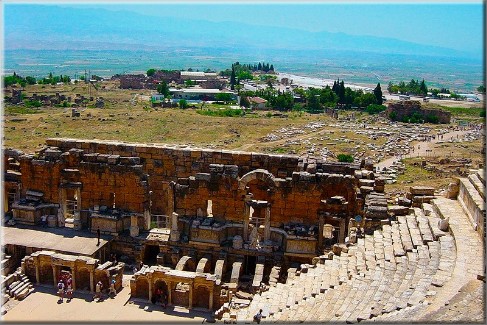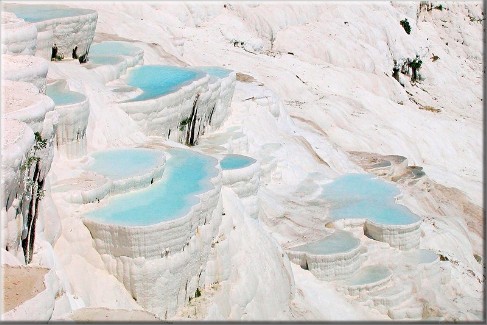Pamukkale, the "cotton castle"
Pamukkale, meaning "cotton castle" in Turkish.
From a distance it looks like white snow in the green hillsides. Then when you are using only your toes in the white limestone pools it is easy to understand why Pamukkale in Turkey is one of the world's wonders.
Pamukkale in southwestern Turkey, about 2 and a half hour drive from Akbuk is this wonderful landscape.
Researchers believe that the mineral rich, particularly calcareous, spring water may have trickled over limestone in nearly 16,000 this yea
From a distance it looks like white snow in the green hillsides. Then when you are using only your toes in the white limestone pools it is easy to understand why Pamukkale in Turkey is one of the world's wonders.
Pamukkale in southwestern Turkey, about 2 and a half hour drive from Akbuk is this wonderful landscape.
Researchers believe that the mineral rich, particularly calcareous, spring water may have trickled over limestone in nearly 16,000 this yea


The Holy City
There are only a few historical facts known about the origin of the city. No traces of the presence of Hittites or Persians have been found. The Phrygians built a temple, probably in the first half of the 3rd century BC. This temple, originally used by the citizens of the nearby town of Laodicea, would later form the centre of Hierapolis.
Hierapolis was founded as a thermal spa early in the 2nd century BC within the sphere of the Seleucid Empire. Antiochus the Great sent 2,000 Jewish families to Lydia and Phrygia from Babylon and Mesopotamia, later joined by more from Judea. The Jewish congregation grew in Hierapolis and has been estimated as high as 50,000 in 62 BC.[1]
There are only a few historical facts known about the origin of the city. No traces of the presence of Hittites or Persians have been found. The Phrygians built a temple, probably in the first half of the 3rd century BC. This temple, originally used by the citizens of the nearby town of Laodicea, would later form the centre of Hierapolis.
Hierapolis was founded as a thermal spa early in the 2nd century BC within the sphere of the Seleucid Empire. Antiochus the Great sent 2,000 Jewish families to Lydia and Phrygia from Babylon and Mesopotamia, later joined by more from Judea. The Jewish congregation grew in Hierapolis and has been estimated as high as 50,000 in 62 BC.[1]
